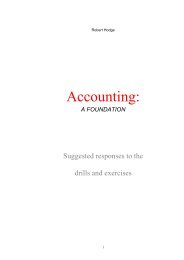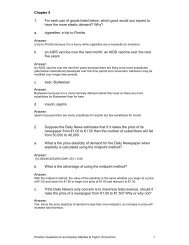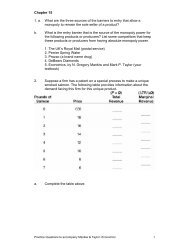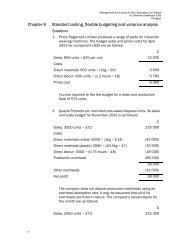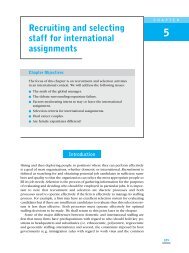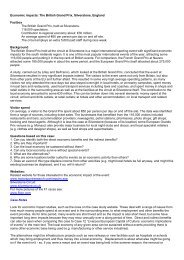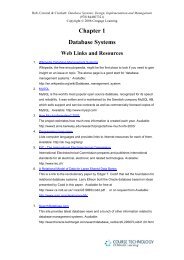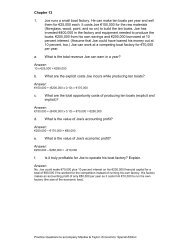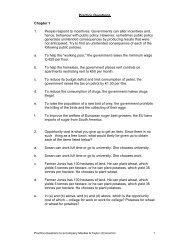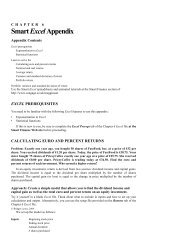Fill out columns three and four of the table above
Fill out columns three and four of the table above
Fill out columns three and four of the table above
Create successful ePaper yourself
Turn your PDF publications into a flip-book with our unique Google optimized e-Paper software.
Chapter 181. Suppose that labour is <strong>the</strong> only variable input in <strong>the</strong> productionprocess for a competitive pr<strong>of</strong>it-maximizing firm that producesc<strong>of</strong>fee mugs. The firm's production function is shown below.a. <strong>Fill</strong> <strong>out</strong> <strong>columns</strong> <strong>three</strong> <strong>and</strong> <strong>four</strong> <strong>of</strong> <strong>the</strong> <strong>table</strong> <strong>above</strong> (<strong>the</strong> marginal product<strong>of</strong> labour <strong>and</strong> <strong>the</strong> value <strong>of</strong> <strong>the</strong> marginal product <strong>of</strong> labour when <strong>the</strong>price <strong>of</strong> <strong>out</strong>put equals €3 per mug).Answer:Practice Questions to accompany Mankiw & Taylor: Economics 1
. Suppose that <strong>the</strong> competitive wage for workers who can make c<strong>of</strong>feemugs is €19 per hour. How many workers should this firm hire? Why?Answer:Three workers because <strong>the</strong> value <strong>of</strong> <strong>the</strong> marginal product <strong>of</strong> each <strong>of</strong> <strong>the</strong> first <strong>three</strong> workersexceeds <strong>the</strong> €19 wage so each worker adds to pr<strong>of</strong>its but <strong>the</strong> <strong>four</strong>th worker only has a value<strong>of</strong> marginal product <strong>of</strong> €18 so hiring <strong>the</strong> <strong>four</strong>th worker would reduce pr<strong>of</strong>its.c. Suppose that colleges that teach pottery skills increase <strong>the</strong> supply <strong>of</strong>workers that can make c<strong>of</strong>fee mugs <strong>and</strong> that this lowers <strong>the</strong>competitive wage for c<strong>of</strong>fee mug workers to €13 per hour. How manyworkers should this firm hire? Why? Does this represent a shift in <strong>the</strong>firm's dem<strong>and</strong> for labour or a movement along <strong>the</strong> firm's dem<strong>and</strong> forlabour? Explain.Answer:Five workers because <strong>the</strong> value <strong>of</strong> <strong>the</strong> marginal product <strong>of</strong> each <strong>of</strong> <strong>the</strong> first five workers nowexceeds <strong>the</strong> €13 wage but <strong>the</strong> sixth worker only has a value <strong>of</strong> marginal product <strong>of</strong> €12 sohiring <strong>the</strong> sixth worker would reduce pr<strong>of</strong>its. This is a movement along <strong>the</strong> firm’s dem<strong>and</strong>curve for labour because <strong>the</strong> value <strong>of</strong> <strong>the</strong> marginal product <strong>of</strong> labour for each worker isremaining <strong>the</strong> same but <strong>the</strong> wage facing <strong>the</strong> firm has changed.d. Suppose <strong>the</strong>re is an increase in <strong>the</strong> dem<strong>and</strong> for c<strong>of</strong>fee mugs <strong>and</strong> that<strong>the</strong> price <strong>of</strong> c<strong>of</strong>fee mugs rises to €5 per mug. <strong>Fill</strong> <strong>out</strong> <strong>the</strong> last column <strong>of</strong><strong>the</strong> <strong>table</strong> <strong>above</strong> to show <strong>the</strong> value <strong>of</strong> <strong>the</strong> marginal product <strong>of</strong> labourwhen <strong>the</strong> price <strong>of</strong> mugs is €5 per mug.Answer:See <strong>the</strong> fifth column in <strong>the</strong> <strong>table</strong>.Practice Questions to accompany Mankiw & Taylor: Economics 2
e. Suppose that <strong>the</strong> competitive wage for c<strong>of</strong>fee mug workers remains at€13 per hour <strong>and</strong> <strong>the</strong> price <strong>of</strong> mugs is €5 per mug. How many workersshould this firm now hire? Why? Does this represent a shift in <strong>the</strong> firm'sdem<strong>and</strong> for labour or a movement along <strong>the</strong> firm's dem<strong>and</strong> for labour?Explain.Answer:Seven workers because <strong>the</strong> value <strong>of</strong> <strong>the</strong> marginal product <strong>of</strong> each <strong>of</strong> <strong>the</strong> first seven workersexceeds <strong>the</strong> €13 wage but <strong>the</strong> eighth worker only has a value <strong>of</strong> marginal product <strong>of</strong> €10 so itwould be unpr<strong>of</strong>i<strong>table</strong> to hire that worker. This is a shift in <strong>the</strong> dem<strong>and</strong> curve for labourbecause <strong>the</strong> value <strong>of</strong> <strong>the</strong> marginal product <strong>of</strong> labour has increased for each worker because<strong>the</strong> price <strong>of</strong> <strong>out</strong>put rose. Thus, <strong>the</strong> firm dem<strong>and</strong>s more workers at <strong>the</strong> same €13 wage.2. Suppose <strong>the</strong>re is an increase in <strong>the</strong> dem<strong>and</strong> for lumber, which raises<strong>the</strong> price <strong>of</strong> lumber.a. Show <strong>the</strong> impact <strong>of</strong> <strong>the</strong> increase in <strong>the</strong> price <strong>of</strong> lumber on <strong>the</strong> marketfor lumberjacks in Exhibit 1.Exhibit 1Answer:See Exhibit 4.Exhibit 4Practice Questions to accompany Mankiw & Taylor: Economics 3
. What did <strong>the</strong> increase in <strong>the</strong> price <strong>of</strong> lumber do to <strong>the</strong> value <strong>of</strong> <strong>the</strong>marginal product <strong>of</strong> lumberjacks <strong>and</strong> <strong>the</strong> wage <strong>of</strong> lumberjacks? Explain.Answer:Increase <strong>the</strong> value <strong>of</strong> <strong>the</strong> marginal product <strong>of</strong> labour <strong>and</strong> <strong>the</strong> wage.c. What will happen to <strong>the</strong> value <strong>of</strong> <strong>the</strong> marginal product <strong>and</strong> <strong>the</strong> rentalrate for timber-growing l<strong>and</strong> <strong>and</strong> for capital that is used for cutting <strong>and</strong>shipping timber? Explain.Answer:When <strong>the</strong> price <strong>of</strong> <strong>out</strong>put rises, <strong>the</strong> value <strong>of</strong> <strong>the</strong> marginal product <strong>of</strong> all <strong>of</strong> <strong>the</strong> inputs increasesaccordingly. Thus, <strong>the</strong> value <strong>of</strong> <strong>the</strong> marginal product <strong>of</strong> both l<strong>and</strong> <strong>and</strong> capital will rise <strong>and</strong> sowill <strong>the</strong>ir rental rates.d. How has this development affected <strong>the</strong> prosperity <strong>of</strong> <strong>the</strong> firm <strong>and</strong> <strong>the</strong>owners <strong>of</strong> <strong>the</strong> factors <strong>of</strong> production employed by <strong>the</strong> firm? Explain.Answer:When <strong>the</strong> price <strong>of</strong> <strong>out</strong>put changes, <strong>the</strong> prosperity <strong>of</strong> <strong>the</strong> firm <strong>and</strong> <strong>the</strong> owners <strong>of</strong> <strong>the</strong> factors <strong>of</strong>production move toge<strong>the</strong>r. In this case, <strong>the</strong> prosperity <strong>of</strong> <strong>the</strong> firm <strong>and</strong> <strong>the</strong> owners <strong>of</strong> <strong>the</strong> factors<strong>of</strong> production are increased.3. Suppose that an enormous amount <strong>of</strong> forest l<strong>and</strong> is cleared foragricultural use in Brazil.a. Show <strong>the</strong> impact <strong>of</strong> this event on <strong>the</strong> market for agricultural l<strong>and</strong> inBrazil in Exhibit 2. What has happened to <strong>the</strong> marginal product <strong>of</strong> l<strong>and</strong><strong>and</strong> <strong>the</strong> rental price <strong>of</strong> l<strong>and</strong> in Brazil?Exhibit 2Answer:See Exhibit 5. This event increases <strong>the</strong> supply <strong>of</strong> agricultural l<strong>and</strong> <strong>and</strong> decreases <strong>the</strong> marginalproduct <strong>of</strong> l<strong>and</strong> <strong>and</strong> <strong>the</strong> rental price <strong>of</strong> l<strong>and</strong>.Practice Questions to accompany Mankiw & Taylor: Economics 4
Exhibit 5b. Show <strong>the</strong> impact <strong>of</strong> this event on <strong>the</strong> market for Brazilian farm workersin Exhibit 3. What has happened to <strong>the</strong> marginal product <strong>of</strong> farm labour<strong>and</strong> <strong>the</strong> wage <strong>of</strong> farm labour?Exhibit 3Answer:See Exhibit 6. The increase in <strong>the</strong> supply <strong>of</strong> agricultural l<strong>and</strong> increases <strong>the</strong> marginal product<strong>of</strong> labour <strong>and</strong> shifts <strong>the</strong> dem<strong>and</strong> for farm labour to <strong>the</strong> right, which increases <strong>the</strong> wage.Exhibit 6Practice Questions to accompany Mankiw & Taylor: Economics 5
4. Describe <strong>the</strong> impact <strong>of</strong> <strong>the</strong> following events on <strong>the</strong> market for carworkers in Swindon, Engl<strong>and</strong>. (Note that Honda operates a factory inSwindon.)a. Honda exp<strong>and</strong>s its factory in Swindon.Answer:The increase in capital available for workers increases <strong>the</strong> marginal product <strong>of</strong> labour, shifts<strong>the</strong> dem<strong>and</strong> for labour to <strong>the</strong> right, <strong>and</strong> increases <strong>the</strong> wage.b. Which? magazine declares Honda to be <strong>the</strong> best-made cars in itsclass.Answer:This event increases <strong>the</strong> dem<strong>and</strong> for Hondas <strong>and</strong> increases <strong>the</strong> price <strong>of</strong> Hondas. Theincrease in <strong>the</strong> price <strong>of</strong> Hondas increases <strong>the</strong> value <strong>of</strong> <strong>the</strong> marginal product <strong>of</strong> labour, shifts<strong>the</strong> dem<strong>and</strong> for labour to <strong>the</strong> right, <strong>and</strong> increases <strong>the</strong> wage.c. Migrants with manufacturing skills from Pol<strong>and</strong> <strong>and</strong> Romania relocateto Swindon.Answer:This event increases <strong>the</strong> supply <strong>of</strong> labour, increases <strong>the</strong> amount <strong>of</strong> labour per unit <strong>of</strong> capital,<strong>and</strong> so decreases <strong>the</strong> marginal product <strong>of</strong> labour, <strong>and</strong> decreases <strong>the</strong> wage.Practice Questions to accompany Mankiw & Taylor: Economics 6



